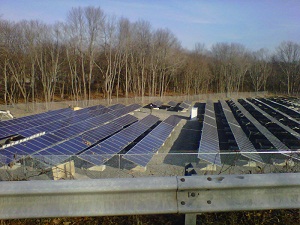Massachusetts business owner's new approach to solar
 Most commonly, when a business owner installs a photovoltaic system, she will do it on her building’s roof or an adjacent property. That’s not the case of the Milk Street solar farm being built in Westborough, Mass. When completed in January 2011, the system will supply electricity directly to the grid and will then be used to offset owner Bruce Forrestall’s utility costs at his local businesses.
Most commonly, when a business owner installs a photovoltaic system, she will do it on her building’s roof or an adjacent property. That’s not the case of the Milk Street solar farm being built in Westborough, Mass. When completed in January 2011, the system will supply electricity directly to the grid and will then be used to offset owner Bruce Forrestall’s utility costs at his local businesses.
Solarflair Energy, Inc. started installing the 240 kilowatt photovoltaic farm in September. It is the second project the company has worked on for Forrestall’s Forrestall Enterprises, Inc. Solarflair previously installed a 20 kilowatt solar system on Forestall’s local carwash. At the first installation, the electricity produced is being used onsite.
In the current arrangement, the nearly $2 million array is connected directly to National Grid’s power lines. Electricity generated by the system is applied to Forestall’s utility accounts at local businesses and residential developments that he owns.
“This is an innovative way for commercial businesses to lower their operating costs, help reduce our dependency on fossil fuel, and educate the community about the current and future opportunities for clean energy technology,” Solarflair said in a statement.
Massachusetts allows electricity produced by such projects to offset electric use elsewhere, said Dan Greenwood, manager of business development at Solarflair.
“You can generate power on a site like that and apply it to your account using Schedule Z,” he said. “So he’s going to generate credits that he can sell back to National Grid.”
Since the project was undertaken through Forrestall’s business, it will benefit from the 1603 Treasury Grant program, under which Forrestall Enterprises will receive a payment for 30 percent of the project costs within 60 days of completion.
Under Massachusetts’ renewable incentives program, the farm also earns Solar Renewable Energy Certificates (SRECs), which Forrestall can sell to electric utilities required to meet the state’s renewable energy standard. The SRECs are in addition to the net-metered credits that the Milk Street solar farm will generate, Greenwood said.
The benefits of selling SRECs can be substantial.
“Over the next 10 years, the SREC market projects to add between 30 cents and 60 cents to the value of each [kilowatt hour] of electricity produced by solar,” said Solarflair. Such PV incentives are helping to reduce the payback time of installing the system. “The system will generate over $5,000,000 in savings and revenue over its 30 year expected life.”
Other people have expressed interest in such a system, Greenwood said.
“There’s been interest from other customers, and some systems that are in various stages of development, and some where we’ve suggested it,” he said.
According to Greenwood, some of those customers are now considering off-site generating facilities like the Milk Street solar farm.
Image courtesy of Solarflair.



